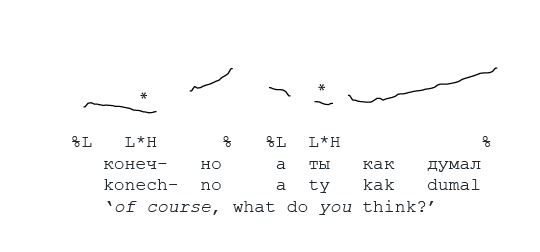

Pitch accent L*H is fall-rise, realized as a fall from high or mid to not-quite-low, followed by a rise to high pitch which is sustained until the end of the utterance. In the examples, L*H occurs on words in a number of different positions of the utterance.
One communicative function of this accent is an elliptic question. Other functions are: polemic answer, summons, enumeration, incompleteness, imperative question.
L*H examples 1-5 have been taken from prepared speech, the other examples are from spontaneous speech.
1. In the first example, pitch accent L*H expresses a non-first elliptic question following the statement “Her son is an excellent painter”.

2. The second example of L*H is also a non-first elliptic question following the statement “In the morning I can’t”.

3. In the third example accent L*H expresses a polemic answer to the question “You what, you managed to write this in one night?”

4. Here is another example of accent L*H expressing a polemic answer to the question “Will you come tonight?”

5. In the next example accent L*H expresses an imperative question following the question “what, you really don’t know?”

6. In this example, pitch accent L*H expresses incompleteness in a narrative.

7. Two examples of an enumeration in a narrative expressed by pitch accent L*H preceded by pitch accent H*M are presented in this utterance.

8. Here is an example of accent L*H expressing a first action in an enumeration of actions.

9. In this example accent L*H expresses a first qualification in an enumeration of qualifications.

10. In this utterance pitch accent L*H also expresses incompleteness. The pitch accent is situated in the final syllable of the utterance in which the full configuration is realized. Note that the realization of H*M is reduced (see reduced pitch accents in the Glossary).

11. This example of pitch accent L*H expressing incompleteness has a long post-tonic part on the high pitch level till the boundary. It is preceded by an utterance with pitch accent H*M realized in the final syllable at the boundary. Though there is no post-tonic part, the accent is easily recognized as a type H*M realization because of its late timing and not so very high pitch target. See also pitch accent H*M, examples 3 and 8.

12. The following utterance is an example of L*H expressing a continuation in a narrative. The high-pitched post-tonic part is sustained till the end of the utterance stretched out over many syllables.
